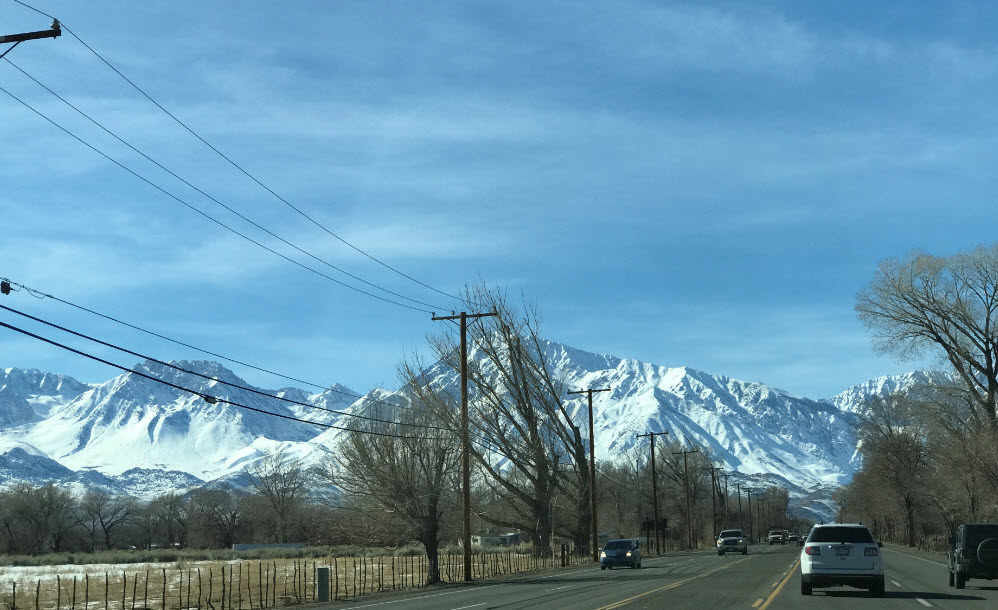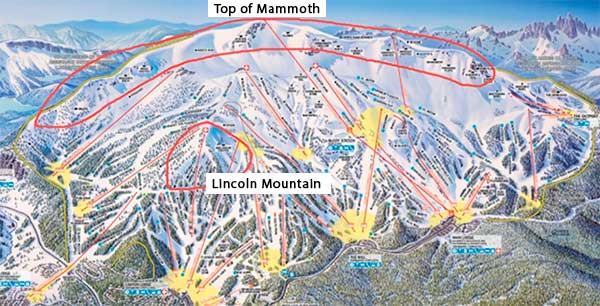Mammoth Mountain
![]() My GNASA included three days at Mammoth. I used my Mountain Collective Pass and their extra day for early sign-ups. I met up with a college buddy who came up from Los Angeles via Route 395 along the eastern side of the Sierras. This route passes by Sequoia National Park, Kings Canyon and Mono Hot Springs. Making this drive on a clear night with a full moon when snow has fallen in the mountains is one of the most beautiful drives you’ll ever make. It’s a bit like a full moon drive through Moab, almost otherworldly.
My GNASA included three days at Mammoth. I used my Mountain Collective Pass and their extra day for early sign-ups. I met up with a college buddy who came up from Los Angeles via Route 395 along the eastern side of the Sierras. This route passes by Sequoia National Park, Kings Canyon and Mono Hot Springs. Making this drive on a clear night with a full moon when snow has fallen in the mountains is one of the most beautiful drives you’ll ever make. It’s a bit like a full moon drive through Moab, almost otherworldly.
Mammoth was my home mountain when I was a boy. The thrills really began as you passed Bishop and gazed at the snow-covered Sierras.

During my GNASA, I arrived at Mammoth at the end of January. It hadn’t snowed in the last five days, but the mountain was reporting over 120-inch base. It was unusually sunny and calm for January. That means no wind or fog. We met up with an old Taos buddy of mine, Michael Shankel. Michael coaches the Junior Alpine Ski Team. He’s been in the ski industry for over 25 years and skis year-round. Michael spends winters in Mammoth and then heads to New Zealand during our summer and fall, New Zealand’s winter.
I’ve taken 30 – 40 days of lessons with Michael over the years. I’d be remiss not to share some of his secrets. He’s a carver. At the beginning of the season, you’ll see Michael laying down perfect railroad tracks from one side to the other down a ski run. He demonstrates perfect control, keeping his skis evenly spaced but acutely weighted depending on where he’s at in the turn resulting in evenly grooved tracks throughout the turn: railroad tracks. Bottom line is you don’t carve well without the ability to tip skis precisely and throughout the arc of the turn. Michael’s a master. Laying down railroad tracks is an exercise I try and use at the start of my season.
I’ve skied Mammoth since I was five. It was always a source of adventure and excitement. There was no better place to be over the Christmas holidays. As I grew older, Mammoth seemed to get better. How Michael describes Mammoth to New Zealanders, is one of the best definitions I’ve ever heard about Mammoth. “It’s [Mammoth] like this total California vibe…. Its like girls wearing puffy coats with nothing on underneath.” As a teenager, Mammoth was sexy, adventurous and always beckoning.
Expert Skiing at Mammoth Mountain
Up Top – Gondola & Chair 23
Mammoth is 3,500 acres of big skiing with a 3,100 vertical drop. Much of it above tree line. As big as Mammoth is, finding the expert terrain is simple. It’s mostly up top, accessible from the Gondola and Chair 23.

One of the unique features of Mammoth is that from the top of the Gondola you can access almost everything on top. You can head skier’s right towards Dave’s Run, stay high toward Head Chute and Dragon’s Back or drop lower toward Chair 9 onto Richochet. Or you can go skier’s left, keep your speed up and head toward Paranoid Flats. A few turns down Paranoid Flats allows you to access Phillipes.
Everything in between are bowls and chutes, most of which open up into wide bowls. Some of the more popular include the Dropout Chutes, Wipe Out Chutes and Climax.
With all the snow that Mammoth gets there are a few things to keep in mind. Cornices at the top can get very high. If you’re not a jumper, you’ll look for traverse access points. Unfortunately, those traverses get well worn by all the snowboarders. There are times when parts of the upper mountain look like rice terraces.
Lincoln Mountain
Lincoln Mountain is accessible via Chair 22. This is home of Mammoth’s Avalanche Chutes; known affectionately as Avi 1, Avi 2 and Avi 3. The terrain is as steep as anything at Mammoth. Avi 1, a right turn after passing the ski patrol shack often requires a traverse over some rocks. The journey means that the powder hounds are often late to ski out this area. Keep in mind that all the Avi Chutes are extraordinarily dangerous and falls in these chutes can easily lead to serious injuries.
Snowboarding at Mammoth
The Great North American “Ski” Adventure doesn’t talk a lot about parks and even less about snowboarding. However, Snowboard magazines consistently ranks Mammoth’s eight terrain parks as among the best in North America; often ranking Mammoth the number one resort for boarders. Everyone from Shaun White to Kelly Clark chases big air in the Mammoth Half Pipes. You can read about Mammoth’s awesome snowboarding features here.
Snow Hunting
Mammoth’s starting elevation is almost 8,000 feet, Mammoth almost always gets snow. It’s unlikely to see ice pellets or rain at Mammoth until late spring or summer, Average annual snowfall at Mammoth is 400 inches. In a good year, the season lasts through the July 4th weekend. All this snow falls because Mammoth is perfectly placed for snowstorms from the North, South or West. This is the great part about being in a whether corridor. The bad part is that winds, blizzards, and fog frequently shuts down the upper mountain.
In Spring, the lower portion of the mountain can get slushy. The good stuff is up high, so who cares. Just stay high.
Mammoth Insider Tips
Mammoth Spring Skiing
In many parts of North America spring skiing simply refers to end-of-season skiing, usually starting in April. It’s different at Mammoth. Historically, Mammoth consistently received large amounts of snow allowing it to remain open through the July 4th weekend. This has not been true over the last decade when drought conditions have seen Mammoth close in early Spring. The good news is that you can simply look at Mammoth’s base and have a pretty good idea if it will stay open late. If there’s more than a 12-foot base, odds are good they’re going for July. You can also call them for some indication of their plans.
It’s hard to communicate how good spring skiing can be at Mammoth. Insiders and industry folk have always known this. I learned it from Chris Kuraisa (an early owner of Heavenly Valley). Every year the old timers, early resort founders, make a pilgrimage to Mammoth. They rent apartments in May and June. They ski, drink and share stories. Chris invited me to stay with him for a week in the early 2000’s. Many of the old timers are passing, but the spring lines they skied at Mammoth are yours for the taking.
The high elevation combined with northern aspects means the top of the Mountain skis well even in warmer conditions.
Hemlock at Mammoth
Mammoth now advertises the Hemlocks. This area is inbounds, but Mammoth calls it side country. It’s accessible off Chair 14 or the Gondola. If its open, check it out.
Mammoth Crowds
Sixty percent of California’s population lives in the Southern portion of the State. Their only big mountain experience is Mammoth. That means on weekends and holidays, Mammoth can entertain a many as 50,000 skiers a day. That’s a lot even with Mammoth’s 50,000 skiers an hour lift capacity. For the GNASA planner, visiting Mammoth midweek is always advised.
The Mountain Doesn’t Operate Expert Terrain During Strong Storms
Mammoth Mountain is in an area notorious for storms, during the winter months Dec-March, combinations of wind, snow and poor visibility conspire to shut down access to all the expert terrain. Mammoth gets lots of snow and storms. This means there are lots of days when they don’t open expert terrain. When they do open, Lincoln Mountain will often open before the top.
Note to GNASA planners. There is nothing more frustrating than being at the base of a great mountain with great snow that you can’t ski. This happens at Mammoth a lot, especially when your trips are short (2 -3 days). If you’re visiting Mammoth during a storm or stormy period, try and extend your trip to at least four days.